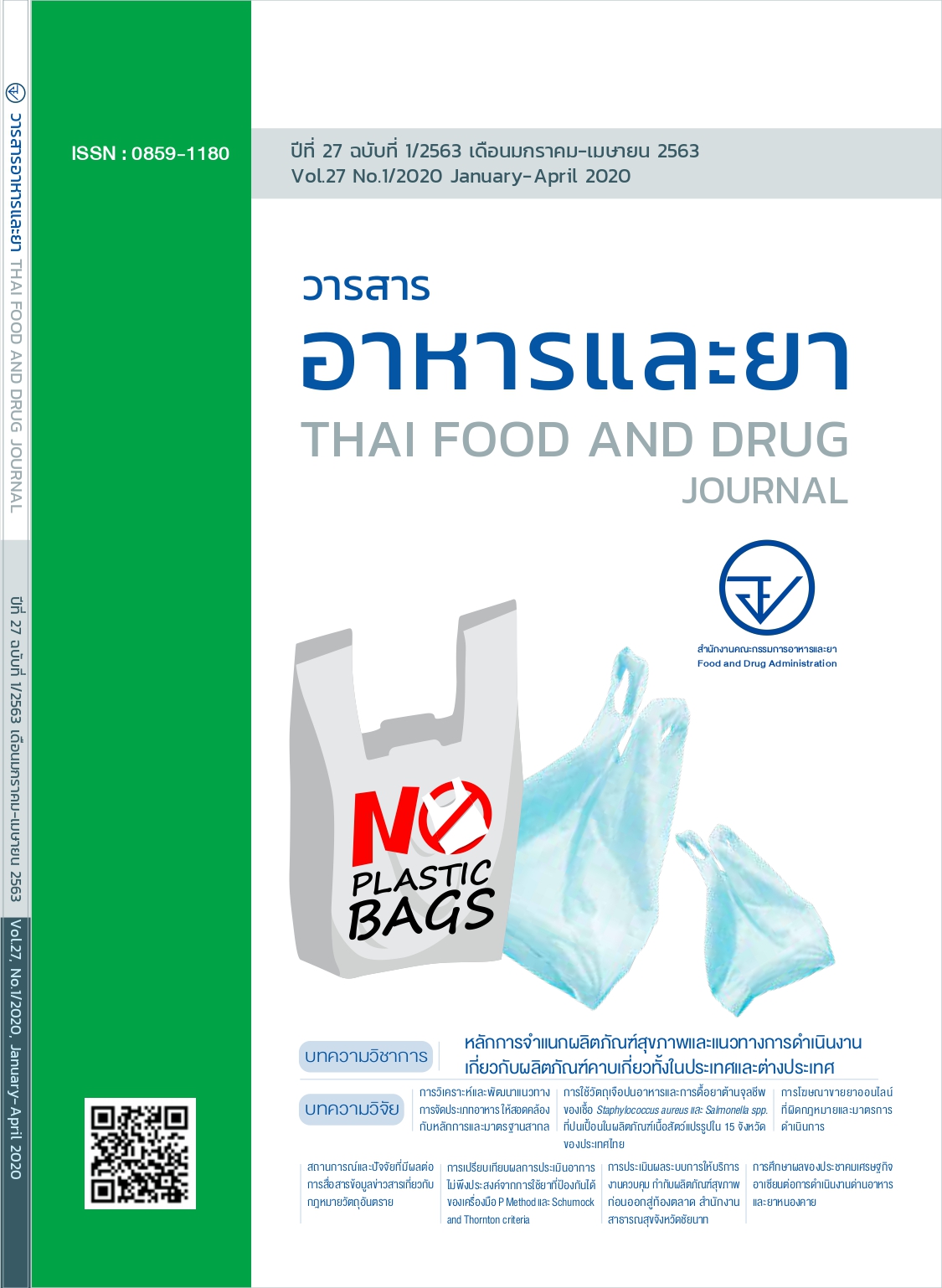การใช้วัตถุเจือปนอาหารและการดื้อยาต้านจุลชีพของเชื้อ Staphylococcus aureus และ Salmonella spp. ที่ปนเปื้อน ในผลิตภัณฑ์เนื้อสัตว์แปรรูปใน 15 จังหวัดของประเทศไทย
Main Article Content
บทคัดย่อ
การศึกษานี้เป็นการประเมินสถานการณ์การใช้กรดเบนโซอิก กรดซอร์บิก สีผสมอาหาร ไนเตรต และ
ไนไตรต์ ตรวจวิเคราะห์โดยวิธี High performance liquid Chromatography พร้อมทั้งตรวจสอบฉลากของ
ผลิตภัณฑ์ที่มีการใช้วัตถุเจือปนอาหาร นอกจากนี้ยังตรวจวิเคราะห์การปนเปื้อนของแบคทีเรียที่ก่อให้เกิดโรค คือ
Staphylococcus aureus และ Salmonella spp. โดยวิธี conventional method พร้อมทั้งศึกษาการดื้อต่อยา
ต้านจุลชีพ โดยวิธี disk diffusion ในผลิตภัณฑ์เนื้อสัตว์แปรรูปประเภทไส้กรอกหมู ไส้กรอกอีสาน แหนม แฮม
กุนเชียง และหมํ่า โดยเก็บตัวอย่างจากตลาดและซุปเปอร์มาร์เก็ต จำนวน 15 จังหวัด ในช่วงเดือนมกราคม-สิงหาคม
2561 รวมทั้งหมด 459 ตัวอย่าง ผลการตรวจวิเคราะห์ พบไนเตรตในไส้กรอกหมู ไส้กรอกอีสาน แหนม แฮม
กุนเชียง และหมํ่า (ร้อยละ 52.5) สีผสมอาหารในไส้กรอกหมู ไส้กรอกอีสาน แหนม และ กุนเชียง (ร้อยละ 7)
28 THAI FOOD AND DRUG JOURNAL : JANUARY-APRIL 2020
มีการใช้วัตถุเจือปนอาหารบางชนิดเกินกว่าที่กฎหมายกำหนด ได้แก่ กรดเบนโซอิก ปริมาณ 1,358 มิลลิกรัมต่อ
กิโลกรัม ในกุนเชียง 1 ตัวอย่าง กรดซอร์บิก ปริมาณ 2,175 - 2,764 มิลลิกรัมต่อกิโลกรัม ในไส้กรอกหมู 3 ตัวอย่าง
และไนไตรต์ ปริมาณ 118.1 - 185.0 มิลลิกรัมต่อกิโลกรัม ในกุนเชียง แหนม และแฮม มีการแสดงข้อมูลการใช้
วัตถุเจือปนอาหารบนฉลากไม่ถูกต้องตามกฎหมาย (ร้อยละ 60.3) คือไม่ระบุชนิดของวัตถุเจือปนอาหารที่ใช้ใน
กระบวนการผลิต (ร้อยละ 45.3) ระบุหมายเลข INS ไม่ถูกต้อง (ร้อยละ 8.5) และมีการแสดง INS ที่ฉลากเป็น
ไนไตรต์ แต่ตรวจไม่พบไนไตรต์ในอาหารดังกล่าว (ร้อยละ 6.5) นอกจากนี้ยังพบว่าไส้กรอกอีสาน แหนม กุนเชียง
และหมํ่ามีการปนเปื้อนของ Staphylococcus aureus ร้อยละ 11.3 ส่วน Salmonella spp. มีการปนเปื้อน
ในผลิตภัณฑ์เนื้อสัตว์แปรรูปทั้งหมด (ร้อยละ 18.7) จากการศึกษารูปแบบการดื้อยาพบว่า ถึงแม้ว่าเชื้อที่พบ
สว่ นใหญจ่ ะตอบสนองตอ่ ยาที่ใชใ้ นการรักษา แตพ่ บเชื้อ Salmonella spp. บางสายพันธุ์ที่ดื้อตอ่ ยาหลายขนานและ
ดื้อตอ่ ยาตา้ นจุลชีพที่สำคัญสำหรับรักษาโรคติดเชื้อแบคทีเรียแกรมลบดื้อยาในประเทศไทย ดังนั้นเพื่อความปลอดภัย
ควรมีการควบคุมการใช้วัตถุเจือปนอาหารอย่างเข้มงวด เพื่อไม่ให้เกิดการใช้อย่างไม่ถูกต้อง ผู้ประกอบการควร
พัฒนากระบวนการผลิต โดยใช้ชนิดและปริมาณของวัตถุเจือปนอาหารตามที่กฎหมายกำหนด ควบคุมสุขลักษณะ
การผลิตทุกขั้นตอน ผู้บริโภคควรเลือกซื้อผลิตภัณฑ์ที่มีการเก็บรักษาสินค้าในตู้แช่เย็น ก่อนบริโภคให้นำอาหาร
มาผ่านความร้อนก่อนรับประทานทุกครั้ง และควรเก็บรักษาอาหารไว้ในตู้เย็น จะช่วยให้ผู้บริโภคลดความเสี่ยง
จากการเจ็บป่วยด้วยโรคอาหารเป็นพิษ
Article Details
เอกสารอ้างอิง
2. Joint FAO/WHO Expert Committee of Food Additives (JECFA). WHO Food Additives Series 35. nitrite [Internet]. 2019 [cited 2019 Jan 14] Available from: http://www.inchem.
org/documents/jecfa/jecmono/v35je13.htm
3. Joint FAO/WHO Expert Committee of Food Additives (JECFA). WHO Food Additives Series 35. nitrate [Internet]. 2019 [cited 2019 Jan 14] Available from: http://www.inchem.
org/documents/jecfa/jecmono/v35je14.htm
4. เวณิกา เบ็ญจพงษ์. ไนเตรตและไนไตรต์ในเนื้อสัตว์แปรรูป. วารสารพิษวิทยาไทย 2559; The 7 th National Conference in Toxicology (NCT 7), 33-39.
5. แสงโฉม ศิริพานิช. อันตรายจากการรับประทานอาหารที่มีสารไนเตรทและไนไตรต์. รายงานการเฝ้าระวังทางระบาดวิทยาประจำสัปดาห์ 2555; 43(23): 353-356.
6. Evaluations of The Joint FAO/WHO Expert Committee of Food Additives (JECF A). [Internet]. 2017 [cited 2019 Jan 14] Available from: http://apps.who.int/foodadditives-
contaminants-jecfa-database/search.aspx
7. กระทรวงสาธารณสุข. ประกาศกระทรวงสาธารณสุข (ฉบับที่ 281) พ.ศ. 2547 ราชกิจจานุเบกษา ฉบับ ประกาศทั่วไป เล่มที่ 133 ตอนพิเศษ 97 ง (วันที่ 20 กันยายน 2547).
8. กระทรวงสาธารณสุข. ประกาศกระทรวงสาธารณสุข (ฉบับที่ 367) พ.ศ. 2557 เรื่องการแสดงฉลากของอาหารในภาชนะบรรจุ. ราชกิจจานุเบกษา ฉบับประกาศทั่วไป เล่มที่ 131, ตอนพิเศษ 102 ง (วันที่
6 มิถุนายน 2557).
9. กระทรวงสาธารณสุข. ประกาศกระทรวงสาธารณสุข (ฉบับที่ 383) พ.ศ. 2560 เรื่องการแสดงฉลากของอาหารในภาชนะบรรจุ (ฉบับที่ 2). ราชกิจจานุเบกษา
ฉบับประกาศทั่วไป เล่มที่ 134, ตอนพิเศษ 97 ง (วันที่ 4 เมษายน 2560).
10. กระทรวงสาธารณสุข. ประกาศกระทรวงสาธารณสุข (ฉบับที่ 381) พ.ศ. 2559 ราชกิจจานุเบกษา ฉบับประกาศทั่วไป เล่มที่ 133 ตอนพิเศษ 298 ง (วันที่ 3 พฤศจิกายน 2559).
11. International Standard Fruit and vegetable products- Determination of benzoic acid and sorbic acid concentrations - Highperformance
liquid chromatography method. (ISO 22855); 2008.
12. Minioti KS, Sakellariou, Thomaidis NS.Determination of 13 synthetic food colorants in water-soluble foods by reversed-phase high-performance liquid chromatography
coupled with diode-array detector. Analytica Chimica Acta. 2007; 583:103-110.
13. Ferreira IM, Silva S. Quantification of residual nitrite and nitrate in ham by reversed-phase high-performance liquid chromatography/
diode array detector. Talanta. 2008;74: 1598-1602.
14. James L, John A. Staphylococcus aureus.Bacteriological Analytical Manual Online. [Internet]. 2016 [cited 2016 May 15]; 1-5
Available from: https://www.fda.gov/food/foodscienceresearch/laboratorymethods/ucm071429.htm
15. International Standard Microbiology of food chain- Horizontal method for the detection,enumeration and serotyping of Salmonella – Part 1: Detection of Salmonella spp., Firstedition (ISO 6579-1); 2017.
16. กระทรวงสาธารณสุข. ประกาศกระทรวงสาธารณสุข (ฉบับที่ 364) พ.ศ. 2556 ราชกิจจานุเบกษา ฉบับประกาศทั่วไป เล่มที่ 130 ตอนพิเศษ 148 ง (วันที่ 31 ตุลาคม 2556).
17. Weinstein Melvin MP, Patel JB, Burnham CA, Campeau S, Conville PS, et al. Performance standards for antimicrobial disk susceptibility tests. Clinical and Laboratory Standards Institute. 2018; M02 13th ed: 1-72.
18. Weinstein Melvin MP, Patel JB, Campeau S, Eliopoulos GM, Galas MM, et al.. Performance standards for antimicrobial susceptibility testing. Clinical and Laboratory Standards Institute. 2018; M100 28th ed. 1-258.
19. Weinstein Melvin M.P, Patel JB, Burnham CA,Campeau S, Conville PS, et al. Clinical and Laboratory Standards Institute. Methods for dilution antimicrobial susceptibility tests for bacteria that grow aerobically. 2018; M07 11th ed. 1-92.
20. Grimont Patrick AD, Weill FX. Antigenic Formulae of the Salmonella serovars. WHO Collaborating Centre for Reference 40 THAI FOOD AND DRUG JOURNAL : JANUARY-APRIL 2020 and Research on Salmonella. [Internet]. 2007 [cited 2018 Jan 2]; 9th ed: [1-166]. Available from: https://www.researchgate.net/publication/283428414_Antigenic_
Formulae_of_the_Salmonella_serovars_9th_ed_Paris_WHO_Collaborating_Centre_for_Reference_and_Research_on_Salmonella
21. Sofos JN. Antimicrobial agents. In Maga,JA and TU, AT, Editors. Food additive toxicology. New York: Marcel Dekker; 1995.P. 235-67.
22. อัญชนา ดุจจานุทัศน์. การยืดอายุการเก็บรักษาหมูยอโดยใช้โซเดียมเบนโซเอต. [วิทยานิพนธ์มหาบัณฑิตสาขาวิชาอาหารเคมีและโภชนศาสตร์ทางการแพทย์].กรุงเทพฯ: จุฬาลงกรณ์มหาวิทยาลัย; 2545.
23. จำรัส เข่งวา, นิยม ดาวศรี. การปนเปื้อนเชื้อ Salmonella spp. และ Staphylococcus aureus ในเนื้อสัตว์ที่โรงฆ่าสัตว์และสถานที่จำหน่ายเนื้อสัตว์ ในจังหวัดตาก ปีงบประมาณ 2557-2559. [อินเตอร์เน็ต][เข้าถึงเมื่อ 7 มีนาคม 2562] เข้าถึงได้จาก: http://region6.dld.go.th/webnew/pdf/y601/final%20Salmonella%20spp.Staphylococcus%20aureus2557-2559%20edit110825.pdf
24. ศุภชัย เนื้อนวลสุวรรณ. ความปลอดภัยของอาหารการประเมินความเสี่ยง (Risk Assessment)โรคอาหารเป็นพิษปัจจัยเสี่ยงในอาหาร. พิมพ์ครั้งแรก.กรุงเทพ ฯ: Sister print & Media Group; 2549.
25. พนิดา ชัยเนตร และคณะ. ซาลโมเนลโลซิสในประเทศไทย: จุลชีววิทยาและระบาดวิทยา.รามาธิบดีเวชสาร 2531; 11(4), 233-244.
26. ธีรพรรณ ภูมิภมร, อุไม บิลหมัด. การดื้อยาของเชื้อ Staphylococcus aureus ในเนื้อสุกรจากโรงฆ่าสัตว์ในภาคใต้ของประเทศไทย ระหว่างปี พ.ศ. 2549-2551. วารสารสถาบันสุขภาพสัตว์แห่งชาติ 2554;6: 1-8.
27. รุ่งนภา ศรีมะณี, ปราการ ประยูรรัตน์, อรุณบ่างตระกูล. การศึกษา Salmonella Serovars และรูปแบบการดื้อยาของเชื้อที่ตรวจพบจากผู้ป่วยโรคอุจจาระร่วงในพื้นที่สำนักงานป้องกันควบคุมโรคที่ 2 สระบุรี. วารสารวิทยาศาสตร์ มศว 2549; 22:62-76.
28. สรรเพชญ อังกิติตระกูล, ประสาน ตังควัฒนา,อรุณ พลภักดี, เดชา สิทธิกล. ความชุกและการดื้อต่อสารต้านจุลชีพของเชื้อซัลโมแนลลาที่แยกได้จากเนื้อวัวในเขตเทศบาลนครขอนแก่น. วารสารวิจัย
มข 2554;16:105-111.
29. O Neill J. Review on antimicrobial resistance.Antimicrobial resistance: Tackling a crisis for the health and wealth of nations. [Internet]. 2014 [cited 2019 Jan 14] Available from:https://arr-review.org/sites/default/files/AMR%20Review%20Paper%20%20Tackling%20a%20crisis%20for%20the%20health%20and%20wealth%20of%20nations_1.pdf


